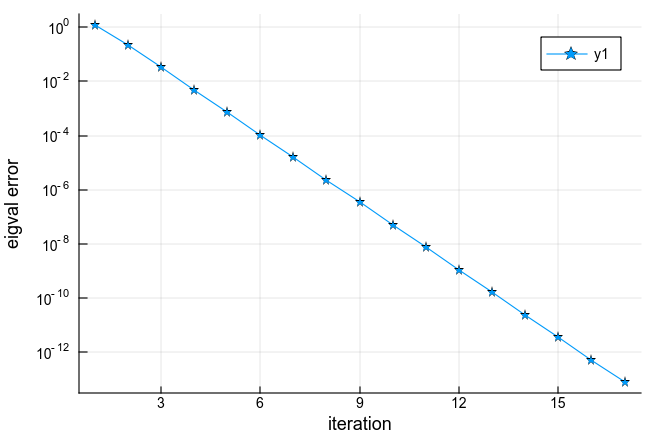Logger
Basic usage
NEP-PACK provides considerable functionality to control the printouts and information of the NEP-solvers. All NEP-solvers take the keyword argument logger which specifies if things should be stored in a logger and/or printed. The main loggers are the PrintLogger which only provides printouts, and ErrorLogger which stores error information.
We illustrate with a combination with the error measure. This example shows how to plot the eigenvalue error of a NEP-solver by using a reference solution.
First let us only user logger=1 in combination with a EigvalReferenceErrmeasure.
julia> A0=[3.0 4 ; 5 6]; A1=[-1.0 0 ; 3.0 1.0];
julia> nep=DEP([A0,A1]); # Delay eigenvalue problem
julia> (λref,_)=resinv(nep,v=[1;1],λ=8,tol=1e-16); # Compute a reference solution
julia> resinv(nep,v=[1;1],λ=8,logger=1,errmeasure=EigvalReferenceErrmeasure(nep,λref));
Precomputing linsolver
iter 1 err:1.2171484853011378 λ=8.0 + 0.0im
iter 2 err:0.21696340485295096 λ=9.000185080448187 + 0.0im
iter 3 err:0.032989925133875886 λ=9.250138410435014 + 0.0im
iter 4 err:0.004864643426348181 λ=9.21228384187479 + 0.0im
iter 5 err:0.0007206309370317854 λ=9.21786911623817 + 0.0im
iter 6 err:0.00010667933045382938 λ=9.217041805970684 + 0.0im
iter 7 err:1.579396864670457e-5 λ=9.217164279269785 + 0.0im
iter 8 err:2.3382761789036977e-6 λ=9.217146147024959 + 0.0im
iter 9 err:3.461794584325162e-7 λ=9.217148831480596 + 0.0im
iter 10 err:5.1251506150151727e-8 λ=9.217148434049632 + 0.0im
iter 11 err:7.587733108493921e-9 λ=9.217148492888871 + 0.0im
iter 12 err:1.1233556307388426e-9 λ=9.217148484177782 + 0.0im
iter 13 err:1.6631140908884845e-10 λ=9.21714848546745 + 0.0im
iter 14 err:2.4622082150926872e-11 λ=9.217148485276516 + 0.0im
iter 15 err:3.645084234449314e-12 λ=9.217148485304783 + 0.0im
iter 16 err:5.400124791776761e-13 λ=9.217148485300598 + 0.0im
iter 17 err:7.993605777301127e-14 λ=9.217148485301218 + 0.0im
iter 18 err:1.0658141036401503e-14 λ=9.217148485301127 + 0.0imThe displayed err are eigenvalue errors and we now wish to plot them:
julia> logger=ErrorLogger();
julia> resinv(nep,v=[1;1],λ=8,
errmeasure=EigvalReferenceErrmeasure(nep,λref),logger=logger);
julia> errvec=logger.errs[1:17,1]; # This contains the iteration errorWe use Plots for plotting:
julia> using Plots;
julia> plot(errvec,yaxis=:log,marker=:star,xlabel="iteration",ylabel="eigval error")The theory predicts linear convergence, which we also observe.

Logger types
abstract type Logger ; endThe type represents a way to log information throughout the algorithms. Error history and other properties can be stored in the logger. The most common Loggers are PrintLogger and ErrorLogger.
As a method developer you want to use push_info! and push_iteration_info!
See also: PrintLogger and ErrorLogger.
struct PrintLogger <: Logger ;
function PrintLogger(displaylevel)When you use this logger, you will obtain printouts in stdout, no other logging. The displaylevel parameter specifies how much should be printed. The higher the value, the more is printed. Zero means no printouts.
struct ErrorLogger <: Logger
ErrorLogger(nof_eigvals=100,nof_iters=100,displaylevel=1)Use this object if you want to save the error history in a method. The displaylevel is interpreted as in PrintLogger. The kwargs nof_eigvals and nof_iters is used to preallocate memory used for saving.
When you use this logger, the error of push_iteration_info!-calls will be stored in logger.errs.
Advanced usage
The logging functionality can be extended in case you want to collect (or throw away) some of the information. You need to create a new type which implements the following methods.
NonlinearEigenproblems.NEPCore.push_info! — Function.function push_info!(logger, [level,] v; continues::Bool=false)Pushes a string v to the logger. If continues=true, the next push_info! (or push_iteration_info!) is connected to this, e.g. line-feed will be omitted.
function push_iteration_info!(logger, [level,] iter; kwargs)Pushes information about a specific iteration iter. Standardized keywords are λ, err and v.